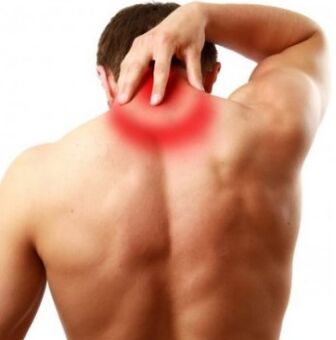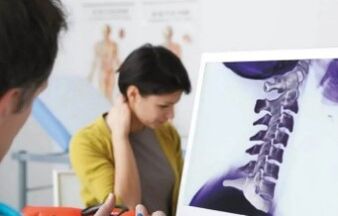Osteochondrosis is a disease of the spine, which is characterized by the development of the cartilage of intervertebral discs and in the surrounding tissues.
Cervix osteochondrosis spineThis is different from the manifestations of chest and lumbar osteochondrosis.Symptoms of cervical osteochondrosis are associated with the anatomical properties of the cervix.The dimensions of the cervical region are smaller than the size of the other classes.The cervical class is constantly experiencing loads, holds its head, and at the same time very mobility.

Causes of osteochondrosis
The causes of the development of the disease are primarily the cause of the aging of the body and the development of bones and cartilage.The following causes of osteochondrosis can also be called:
- A violation of posture,
- Reducing motor activity as a result of a sitting lifestyle,
- The overweight which is the result of metabolic disorders, the load on intervertebral discs,
- hereditary factor,
- Long -term physical activity,
- Disorders of the spine.
Uniform physical activity, proper nutrition and a healthy lifestyle significantly reduce the likelihood of the disease and reduce the effect of general well -being.
Symptoms of osteochondrosis of the cervical spine
The cervical osteochondrosis manifestations differ from the symptoms of other spine.The reason for this is that the cervical vertebrae are different structures and very close.Therefore, every displacement shows severe pain.In addition, a nervous bundle and arteries often squeeze the cervix's spine.
The spine cervical osteochondrosisThe following symptoms show:
- Feelings of pain - the pain is felt in different parts of the body.The reason for this is the fact that nerve endings and the muscles of the right part of the body were pinched.
- Due to the sting of the upper limbs and motor activity, the weakness of the upper limbs.
- Difficulties in turning the head, crunching the vertebrae in the cervical region due to changes in the structure of the intervertebral disk and the appearance of bone formations.
- Low sensitivity of hands.
- Weakness and dizziness appear due to the pinches of the artery, which ensures blood and nutrition into the brain.
- Reduction of hearing and vision - appears in the final stage of the disease when the cerebral circulation is disturbed.
Signs of an osteochondrosis cervical class
- Rine syndrome - the nerve beam is characterized by cervical stings.This is manifested by severe pain that can be felt in the shoulders, the spatula.
- Vertebrate syndrome - the strongest headache, in the temples and the most powerful headache of the back of the head.
- Reflex syndrome - which is characterized by severe pain in the cervical region, which can increase with any head movement.The pain can move to the shoulder and on the chest.
- Cardinal syndrome - similar to an angina pectoris attack, which is extremely difficult to determine.
The degree of development of osteochondrosis of the cervical spine
As it develops, the disease passes through several stages.Each section has its own characteristics and characterized by certain characteristics.
- Stage 1.The tissue of the vertebrae is gradually collapsed.The symptoms of the disease are not noticeable.And very often, patients simply do not notice them, but associate fatigue and pain to overtime and stress.
- Section 2.Height, the disk begins to decrease and cracks appear on it.The patient experiences constant pain, weakness, and face numbness.
- Section 3.Drops of the plates form, cervical blood vessels and muscles are damaged.There are complaints about dizziness, pain on the back of the head.
- Stage 4.The bone tissue, which protects the vertebrae from excess load, begins to grow, resulting in nerve endings.The movements have stiffness and the adjacent joints are damaged.
Dangers of osteochondrosis of the cervix
There are many nerves and arteries in the cervix region that provide nutrition to the brain.In the event of a violation of their work, the brain does not get enough nutrition for normal operation.This situation can violate a person's motor activity, cause pain in the limbs, and loss of coordination.
In the advanced stage of osteochondrosis, ischemia, stroke, and many other disease dangerous to human life can develop.
Therefore, if any symptoms appear with this disease, it is advisable to seek medical help.
Diagnosis of the cervical spine
The following type of diagnosis is used to examine spinal diseases:
- The X -Ray image is not an effective way to diagnose this disease,
- MRI (magnetic resonance imaging) shows bone structures, disk hernia and their size,
- CT (computer tomography) is not effective compared to MRI as this diagnostic method is difficult to determine the size of the hernia,
- Ultrasonic duplex scanning is used when total blood flow is disturbed.This test shows the existing speed of blood flow and the presence of obstacles.
Treatment of osteochondrosis of the cervical spine

Treatment of osteochondrosis of the spine cervical should be done in the complex, depending on the situation.Thanks to a comprehensive and individual approach, a positive effect can be achieved, which includes medication, physics, physiotherapy, massage and traditional medicine.
During the aggravation period, the treatment of osteochondrosis of the cervical cervix is aimed at enhancing blood circulation and getting rid of muscle cramps.In this case, agents are prescribed that improve bloodstream, anti -inflammatory and analgesics, and vitamin complex.
Media Physical Education for the Cervical Region osteochondrosis
Therapeutic gymnastics gives visible results and is less dangerous during the recovery phase.The effect of physiotherapeutic exercises is to restore the bloodstream in damaged parts of the body.By performing the practice of physiotherapeutic exercises, the patient should not feel pain and discomfort.
The practical set of the cervical spine is designed to strengthen the cervical muscles and prevents the development of osteochondrosis of the cervix.
Massage for osteochondrosis of the cervical spine
The massage is performed to strengthen the sound of the muscles and relieve pain.Depending on the stage of the disease, different massage methods are made.The classic massage techniques are as follows:
- Stroching - This technique consists of effect on the surface layers of the skin.The massage begins with a collar and remains clavicula and armpit.
- Clamp - in this case, during massage, the effect refers to the deeper layers of the skin.With the neck with the thumb and index finger, you make movements to grab the skin that resembles the tightening.
- Rubbing - performed to heat and rest the skin to improve blood supply to the cervical spine in the area.
- Kneading - has special restrictions as it affects deeply lying tissues.If this technique is done incorrectly, the patient may be harmful.
In cases where the patient's feeling of pain occurs only on one side, the massage should start from a healthy part of the neck, gradually moving to the part of the cervix region where the pain appears.
Massage can be done both at home and at a medical institution.However, when implementing it, you should be very careful not to provoke the worsening of the disease or to be worse.
Preventing cervical osteochondrosis
To prevent the disease and development of the disease, it is recommended to follow simple rules:
- Lead a healthy lifestyle, perform physical exercises, visit the pelvis regularly;
- diversify the diet of food rich in magnesium and calcium;
- In the case of sitting work, heat the heating several times a day;
- You need to choose an orthopedic mattress and a comfortable pillow to sleep.






















